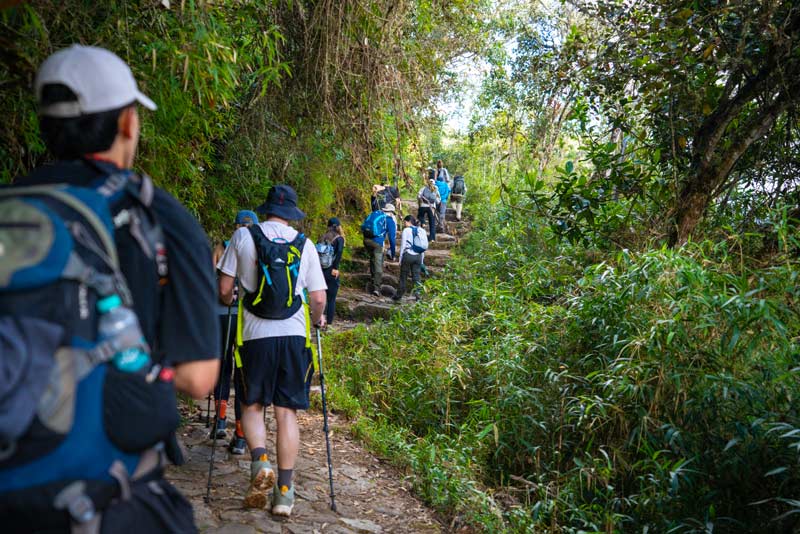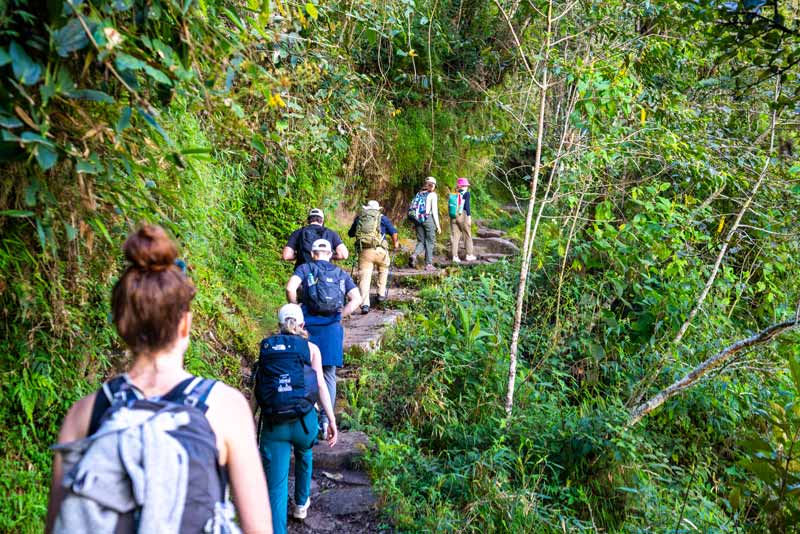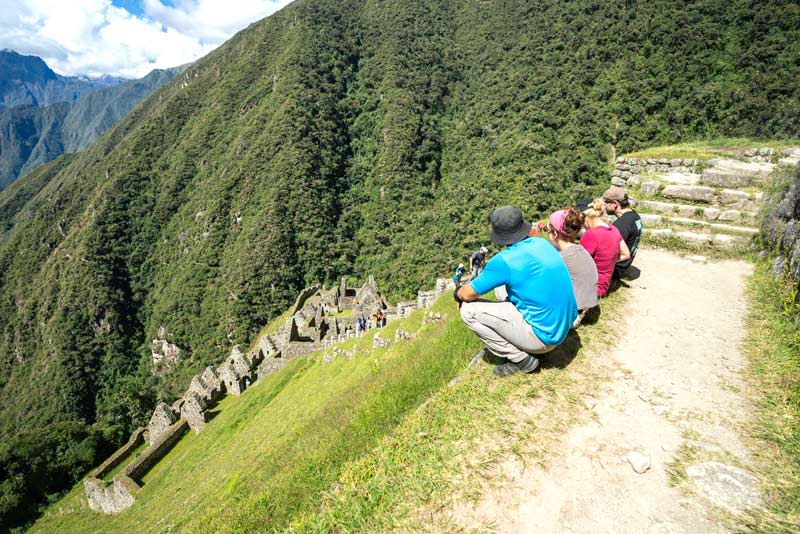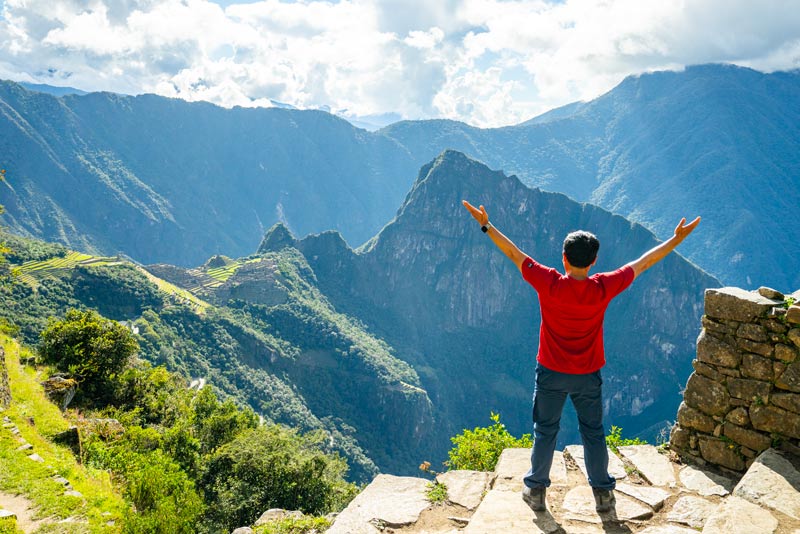Doing the Inca Trail if you are not in shape: is it possible?
Are you attracted to the idea of hiking the Inca Trail, but feel your fitness level might be against you? Many people ask themselves the same question before taking the plunge. Is it necessary to be in shape? In this blog, we’ll tell you what you need to know if you’re thinking about hiking the Inca Trail without being in top physical shape. With clear information and practical advice, you’ll be able to decide if it’s possible for you… or if it’s worth doing a little preparation before attempting it.
- What if I’m not in shape?
- Tips if you are not in shape, but want to be fit
- Easier alternatives to the Inca Trail
- Frequently Asked Questions
What if I’m not in shape?
Is it dangerous to do the Inca Trail if I’m not fit?
It’s not necessarily dangerous, but it can be more challenging if you’re not in shape. The Inca Trail is quite physically demanding: there are sections with many stone steps, steep climbs, and high altitudes that can cause fatigue or altitude sickness. Being physically unprepared increases the risk of exhaustion, muscle aches, or even minor injuries.
It’s a good idea to prepare in advance. You don’t need to be an athlete, but it’s good to have basic endurance and get used to walking for several hours at a time. Additionally, maintaining a good pace and resting when necessary goes a long way to avoiding complications along the way.
Can I do the Inca Trail if I’m overweight?
Yes, you can, but it will depend on your overall health and fitness. Many overweight people have successfully completed the Inca Trail, but it’s important not to underestimate the rigors of the route, as the altitude, climate, and length of the hike can be challenging regardless of your weight.
It’s essential to visit a doctor before your trip to ensure you’re fit for a multi-day hike , as well as to train ahead of time and take care of your diet, as this will make a big difference.
Which parts of the trail are the most difficult?
The most difficult part is usually the second day, when you climb to the highest point known as the Abra Warmiwañusca , at more than 4,200 meters above sea level. This section is demanding due to the incline and altitude, which can cause extreme fatigue and shortness of breath if you are not well acclimatized.
There are also sections with many stone stairs, both uphill and downhill, which can be tough on the knees. Although there are breaks and ample time to walk calmly, it’s important to always be physically prepared.
| Attractions of the Inca Trail | Altitude |
|---|---|
| Patallacta (Llactapata) | 2,600 meters above sea level |
| Runkurakay | 3,750 meters above sea level |
| Sayaqmarca | 3,650 meters above sea level |
| Chachabamba (Only on the short Inca Trail) | 2,100 meters above sea level |
| Wiñay Wayna | 2,650 meters above sea level |
| Intipata | 2,850 meters above sea level |
| Inti Punku | 2,745 meters above sea level |
| Machu Picchu | 2,430 meters above sea level |
What should I do if I get tired during the Inca Trail?
The first thing to do is slow down; it’s not a race, so the best thing to do is walk at your own pace and take breaks when you need to. Breathing deeply, drinking water, and eating a light meal can help you regain energy, and remember that the guides are trained to assist if anyone needs help.
If you feel very tired, let your guide know, as they can reorganize the group so you can progress more smoothly and also give you tips to alleviate fatigue. Carrying trekking poles helps reduce the strain on your legs and maintain better balance.
Tips if you are not in shape, but want to be fit
What exercises should you do before the Inca Trail?
Ideally, focus on long walks, stair climbs, and endurance-boosting exercises like jogging, biking, or hiking.
You can also add leg-strengthening exercises and cardio activities to improve lung capacity. The important thing is to be consistent: you don’t need to train at a professional level, just get your body used to physical exertion.
How far in advance should I train?
It is recommended to start at least 2 to 6 weeks before the trip , and if you lead a sedentary lifestyle, it is better to start earlier so that your body gradually adapts to the effort and you reduce the risk of becoming exhausted during the hike.
Start with gentle walks and increase the intensity over time. Consistency is key, and even if you do gentle exercise, doing it several times a week will prepare you much better.
Can you rent a horse or get help along the way?
Horses are not permitted on the classic Inca Trail for conservation and safety reasons , as it is a protected historical route and the terrain in many parts is not suitable for pack animals. However, porters will carry some of your luggage.
If you need assistance, you can talk to the travel agency in advance, as some offer personal porters for an additional fee, allowing you to hike with just a small backpack. This greatly lightens the effort and is a good option if you’re not used to long hikes.
What pace should I take if I’m a beginner?
If it’s your first time, it’s best to walk at a slow, steady pace without rushing , as some people often try to go quickly for the first few minutes and then tire quickly. The important thing is to listen to your body and rest whenever you need to.
The guides are well-versed in timing and organize the group with strategic breaks, usually with one guide at the front and another at the back to accompany those who are slower. Don’t worry if you’re last; the important thing is to move forward without pressure.
Easier alternatives to the Inca Trail
Is there a short version of the Inca Trail?
Yes, there is a two-day version of the Inca Trail, ideal for those short on time or who prefer a more leisurely hike. This route begins at kilometer 104 of the train to Machu Picchu and is hiked for only one day before reaching the archaeological site.
It’s less physically demanding and doesn’t exceed 2,700 meters in altitude, although it’s shorter. It offers beautiful landscapes and allows you to reach Machu Picchu via the Sun Gate. It’s an excellent option for those who don’t want to hike for four days.
Note: Traveler, if you decide to go for this option, it’s important to know that this route, just like the 4-day version of the Inca Trail, must be booked well in advance. This route also has a very limited number of entries and extremely high demand, causing spaces to fill up quickly.
Which routes are easier than the Inca Trail?
Some easier routes than the Inca Trail are the Huchuy Qosqo hike and the Lares Trek , although the latter also has challenging sections. These options involve fewer stairs and shorter hikes.
There are also day trips like the Maras Moray Tour or the Sacred Valley , which are more accessible and don’t require as much physical preparation. If you’re looking for a more peaceful but equally beautiful experience, these routes can be a good alternative.
Is the 2-day Inca Trail better for beginners?
Yes, the 2-day Inca Trail is much more recommended for beginners. It’s a single day hike with fewer steep climbs and descents , which significantly reduces the physical strain compared to the 4-day hike for the full trail.
Plus, it offers an experience very similar to the classic route, including arrival through the Puerta del Sol. It’s ideal if you want to experience the excitement of the Inca Trail without the demanding nature of several days of hiking or the risk of high altitude for so long.
What is the difference between the Inca Trail and other routes like Salkantay or Lares?
The Inca Trail is a historic route that reaches Machu Picchu along the same path used by the Incas. It’s the only one that ends directly at the citadel through the Sun Gate. Therefore, it requires advance permission and has a limited number of visitors.
On the other hand, Salkantay and Lares are alternative routes that don’t require a special permit. Salkantay is more challenging in altitude and distance, but offers varied landscapes, just like the Lares Trek. Each route has its own charm, but if you’re looking for history and a unique experience, the Inca Trail is the ideal option.
Frequently Asked Questions
1) Do you need to be in shape to do the Inca Trail?
Remember! It’s very important to be in good physical condition to complete this route without complications. Also, avoid overexerting yourself along the way, as you could wake up exhausted or with muscle aches the next day.
2) How many hours do you walk per day?
Typically, you walk between 5 and 8 hours a day. This time is approximate, as it all depends on your pace. The most important thing is that your pace is respected; no one will rush you.
3) What happens if I can’t continue along the way?
That’s unlikely to happen, so have confidence in yourself. With the right support, you’ll make it safely to each campsite, where you can rest and recharge. Don’t let negative thoughts stop you!
4) Is there telephone service on the Inca Trail?
Take note! Cell phone service is very poor on the Inca Trail, as it traverses a remote area. Even so, hiking surrounded by nature and incredible landscapes will be enough to forget about mobile networks for a few days.
5) Can the Inca Trail be done with children or older adults?
Yes, it can be done. There are no restrictions, but it’s very important for both children and older adults to be in good physical condition and in good health. These aspects are essential for completing the entire route without problems.
6) Is it advisable to take pills for altitude sickness?
Yes, you can take them if you experience symptoms of altitude sickness. However, this is rare on the Inca Trail, as most people acclimatize in Cusco before starting the trek, which helps them be better prepared.
7) How much does it cost to do the Inca Trail?
You can find many offers online, ranging from $300 to $1,500. The price varies depending on the type of service you choose and the level of comfort you desire during your hike.
8) How many days does the traditional Inca Trail last?
The traditional or classic Inca Trail lasts four days. During this journey, you’ll visit almost all the archaeological sites along this route, and as a final reward, you’ll reach the citadel of Machu Picchu.
9) Can the Inca Trail be done at any time of the year?
Travelers, please note that the only month this route is unavailable is February. Why? During this time, maintenance work is being carried out to ensure the trail is in optimal condition for your visit.
10) Are there bathrooms or showers along the way?
Traveler, this is a service you won’t find along the route. However, since you’ll be accompanied by a travel agency, they’ll usually offer you small containers of water that you can use to clean yourself.
Advice from people who have been there
 By: Mario. B
By: Mario. B“One of the best routes“
“An extremely incredible route, it was worth it to have walked for days and to have this beautiful gift of knowing one of the wonders of the world, thank you!“
By Ticket Machu Picchu – Last updated, June 9, 2025



